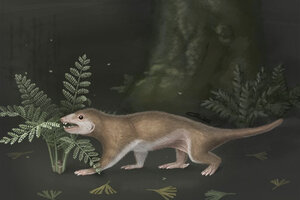When did mammals evolve? Two new papers disagree.
Two papers published in Nature disagree on when mammals evolved but also broaden the portrait of mammalian evolution.

Megaconus, depicted here in an artist's illustration, is not a true mammal, but had distinctly mammalian features.
April Isch/University of Chicago
Once, somewhere in what is now China, lived an animal with the fur and teeth – and poisonous spur – of a mammal, but with the ears and ankles of a reptile.
Called Megaconus, the 165-million-year-old precursor to modern mammals and companion to feathered dinosaurs is a new data point in paleontologists’ search to pinpoint how and when the features of modern mammals evolved. The animal, described in a paper published in Nature, suggests that mammalian characteristics well predated the existence of actual mammals.
But at the same time, a separate paper published in Nature has classified another fossil in the same lineage to which Megaconus belongs not as a mammal precursor, but as a true mammal, a finding that would dial back the evolution of mammals some 50 million years. The conflicting findings underscore the difficulties of piecing together the still enigmatic evolution of mammals.
Zhe-Xi Luo, a professor of organismal biology and anatomy at The University of Chicago and an author on the first paper, likens the evolution of mammals to a “vast bush” made of about two-dozen branches, the majority of which were “pruned in extinction.” Just three of those branches were spared natural selection's gardener’s shears and now form the three lineages of modern mammals.
Megaconus belongs to the Haramiyida lineage, one of the snipped branches. That group dates back to the Late Triassic, some 40 million to 50 million years before the appearance of true mammals and is not included in the Mammalia class.
Until now, the fossil record for haramiyidans was sparse, and most evidence about how that those animals lived was based on tooth fragments alone. But the Megaconus skeleton, recovered in Inner Mongolia, China, is almost complete, offering up new clues about just when and where mammal features appeared.
“We’re always trying to understand how mammal attributes evolved in the fossil record,” said Dr. Luo. “We now have tangible models of evolutionary milestones.”
Most exciting to scientists are the hair impressions on the rock in which Megaconus was found, making it the second non-mammal fossil to be fingered as having had fur (the first was described in 2006 and belonged to a different extinct lineage of pre-mammals). Based on those fossil impressions, Megaconus had darker hair on its back and soft, white fur on its underbelly, a pattern similar to the fur that clothes modern rodents.
Megaconus also had a poisonous ankle-spur, similar to that found on a platypus, a mammal. An omnivore, the animal likewise had a dental structure similar to what is seen in modern mammals, with high-crowned teeth and fused roots.
Still, Megaconus had some reptilian features, including a middle ear attached to its jaw and reptilian anklebones.
“Megaconus looked like a mammal, but strictly speaking it was not,” said Thomas Martin, a paleontologist at the University of Bonn in Germany and an author on the paper.
But a separate paper, also published in Nature, reports the finding of another, somewhat younger animal, called Arboroharamiya, that the authors also put in the Harmiyida group but describe it as a true mammal, with a simple jaw and mammalian ear-bones. That would make harmiyidans part of the mammal group, rolling back the origin of mammals to about 215 million years ago – or about 50 million years earlier than most paleontologists have put that evolutionary moment.
“We provided new evidence from an individual with teeth, jaws and skeleton preserved so that we know much more about the morphology of this group of mammals and supports the view that mammals originated very early in the late Triassic,” said Jin Meng, a paleontologist at the American Museum of Natural History in New York and an author on the second paper, in an email interview.
The second paper is in apparent contradiction to the paper describing Megaconus, in which harmiyidans are non-mammals and precede true mammals by millions of years.
“This discrepancy is very enigmatic,” said Dr. Martin. “At the moment it’s quite a problem.”
Martin suggested that Arboroharamiya might not be a harmiyidan, but could instead be part of the Multituberculata group, an extinct but more recent lineage that belongs to the mammal class. That would resolve the contradiction and put mammal origins back in the Jurassic, not the Triassic. He added that he hoped to view and examine the specimen.
Still, the authors on the first paper said that, regardless of whether or not Arboroharamiya was a harmiyidan, the results of the second paper were still exciting in adding another highly specialized species to the late Triassic period – Arboroharamiya was a tree-dweller and Megconus was a ground-dweller – and broadening an understanding of a complex and diverse Triassic ecosystem.

